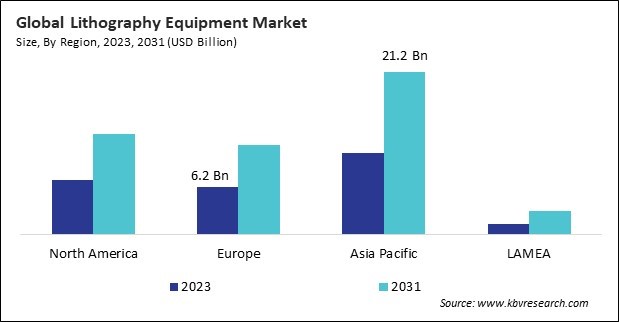According to a new report, published by KBV research, The Global Lithography Equipment Market size is expected to reach $49.1 billion by 2031, rising at a market growth of 8.9% CAGR during the forecast period.
The Deep Ultraviolet (DUV) segment is leading the Global Lithography Equipment Market by Type in 2023; thereby, achieving a market value of $37.3 billion by 2031. DUV systems are widely used to produce a variety of chips and components, providing a proven solution for manufacturers aiming to maintain efficiency and production scale without incurring the high costs associated with newer technologies. Manufacturers who are seeking a balance between precision and cost are particularly fond of DUV lithography due to its adaptability across various nodes and its suitability for high-volume manufacturing.

The MEMS segment registers a CAGR of 8.6% during (2024 - 2031). MEMS devices, which integrate mechanical and electrical components at the microscale, are essential in various applications, including sensors, actuators, and medical devices. The precision and scalability offered by advanced lithography equipment are crucial for fabricating MEMS components with the required accuracy and reliability. The expanding adoption of MEMS technology across industries such as automotive, healthcare, and consumer electronics has driven the demand for specialized lithography solutions tailored to MEMS fabrication needs.
The ArF Immersion segment is generating the maximum revenue in the Global Lithography Equipment Market by Technology in 2023; thereby, achieving a market value of $17.3 billion by 2031. The ArF immersion lithography segment is driven by the need for high-resolution patterning, which is essential in advanced semiconductor manufacturing, particularly as the industry moves towards smaller nodes and more compact designs. By filling the gap between the lens and wafer with water, ArF immersion allows for enhanced resolution, making it invaluable in producing chips used in high-performance applications like AI, 5G, and high-speed computing.
The 2.5D Interposer segment exhibits a CAGR of 8.4% during (2024 - 2031). 2.5D packaging utilizes an interposer—a substrate that interconnects multiple chips side by side—to achieve high-density integration without the complexities of full 3D stacking. This approach balances performance and manufacturability, making it attractive for applications requiring high bandwidth and efficient thermal management, such as graphics processors and networking devices. The fabrication of 2.5D interposers requires precise lithography processes to create fine-pitch interconnections, thereby driving demand for specialized lithography equipment in this segment.
Full Report: https://www.kbvresearch.com/lithography-equipment-market/
The Asia Pacific region dominated the Global Lithography Equipment Market by Region in 2023; thereby, achieving a market value of $21.2 billion by 2031. The North America region is expected to witness a CAGR of 8.2% during (2024 - 2031). Additionally, The Europe region would capture a CAGR of 8.4% during (2024 - 2031).
By Type
By Application
By Technology
By Packaging Platforms
By Geography
 Unique Offerings
Unique Offerings